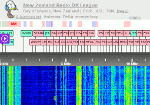I guess most of us with a receiver that goes down to the Longwave band (150 -500kHz) has had the odd tune around and never found very much of interest, probably a heap of aeronautical beacons pumping out Morse code ids in rather boring ad infinitum, some of us may have tried to decode them and find out where they were located. A few may have found the Australian voice weather reports broadcast over some of their beacons; all of us would have heard horrendous levels of static as Longwave is great for picking up every lightning crash (that’s what this static is) from this half of the planet. Some times the static is so bad you’ll quickly give up and head back to more usual climes – like MW or bed! The more persistent of us would realise that those mega-watt and even 2 megawatt stations from Europe, Asia, the Middle East and even Africa must stand a chance of getting through – after all, there are no broadcast stations in our region using Longwave – and if conditions are right, then who knows what might be heard!
It was with this theory that I started to tune around the LW band back in 1987 – prior to 1986 none of my receivers went below 500kHz. The first things I heard were Russian stations – particularly from Eastern Siberia and Far Eastern Russia. You could hear them from their sunset, depending on the time of year anywhere from 1030z onwards, right through the night until our sunrise when signals would very abruptly disappear. Back in those days Russian stations carried the “Mayak” and home service programs and were nigh on impossible to verify (and still are!). But with the great conditions we experienced around 1985-1990, all sorts of interesting things popped up, like France 162, Bod, Roumania 153 and others not quite so strong or readable, e.g. Germany 183, Turkey 180 and some Eastern Russians.
Since those early days I have spent a deal more time on LW and heard Ulaan Baatar, Mongolia on 164, Bolshakovo, Kaliningrad 171, Turkey 162, 180 & 198, Algeria 198, Jordan 207 and heaps more Russians. With the exception of the Russians and Mongolia, most of these stations are heard in the period from about an hour before our sunrise, usually to as soon as Old Sol pokes his head above the horizon – however, exceptional conditions in late April of ’98, saw France 162 fading out at 2045 UTC (8:45 am local) and Jordan 207 at approximately 2110 UTC (9:10 am local) – so, the LW band does hold a few surprises!
You may notice that most of these frequencies are in the lower part of the LW band – well, there are simply fewer beacons down there. And if you have a notch filter, here is a tuning trick I use to nullify the beacons, adjust the notch control to take out the audio frequency of the beacon and you can just about get rid of it entirely. They are all fixed at a certain freq and are very stable, try it out!
I have yet to hear a long-wave station via long-path, that is around our sunset, so saying, I’ve never tried before when reception conditions on the lower frequencies has been very good, so another Longwave surprise may be in store for me.
The WRTH is an excellent source of info on these stations. You will find that there are two different programs carried by the Russians and this will help you to work out to which one you are tuned. Nearing our sunrise you may well find stations that are not in parallel with the others – this may mean you are hearing one of the former Soviet Republics who still use LW, or a station from further to the West as the Russians use three time-zone breaks, i.e., in the East the programs run three hours behind the West. This is what alerted me to logging Bolshakovo on 171 – it was the only Russian carrying that program at that time. Just recently I have a QSL directly from the State Radio and TV Company in Petropavlovsk which carries the Radio Rossii program on 180kHz. The report was sent in English along with a prepared card and US$1-00. The card was returned signed and stamped with a verification text in Russian added. (Thanks to Karel Honzik in the Czech Republic for the translation!).
The other thing to be aware of on LW, is that stations don’t strictly follow the 9kHz spacing rule. Here are the actual frequency spacing: 153, 162, 164, 171, 177, 180, 183, 189, 198, 207, 216, 225, 227, 234, 243, 252, 261, 270 & 279. Those of you lucky enough to have multiple memories in your receivers may be able to store all of these to make tuning a doddle!
And there is more down there, listen around 181kHz and you may well pick up this single-frequency amateur radio allocation. There are a number of active ‘hams’ around who run very low power. If you venture below 153kHz you may find the odd utility including Transpower’s current-carrier radio-telephone, which sends RF down High Voltage (110kV up!) transmission lines!
So if you find MW unappealing because of the interference and still want a DX challenge – how low can YOU go!



